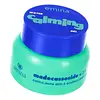What's inside
What's inside
 Key Ingredients
Key Ingredients

 Benefits
Benefits

 Concerns
Concerns

 Ingredients Side-by-side
Ingredients Side-by-side

Water
Skin ConditioningCaprylic/Capric Triglyceride
MaskingSqualane
EmollientTetramethylcyclotetrasiloxane
Glycerin
HumectantButylene Glycol
HumectantSodium PCA
HumectantBetaine
HumectantCyclopentasiloxane
EmollientPhenoxyethanol
PreservativePropylene Glycol
HumectantDimethicone
EmollientPanthenol
Skin ConditioningAloe Barbadensis Leaf Extract
EmollientTriethanolamine
BufferingAcrylates/C10-30 Alkyl Acrylate Crosspolymer
Emulsion StabilisingAcrylates/Acrylamide Copolymer
MoisturisingParaffinum Liquidum
EmollientSimmondsia Chinensis Seed Oil
EmollientAllantoin
Skin ConditioningBHT
AntioxidantTocopheryl Acetate
AntioxidantZinc Gluconate
Skin ConditioningDisodium EDTA
Triethylene Glycol
MaskingParfum
MaskingGlyceryl Polyacrylate
Polysorbate 85
EmulsifyingHydrolyzed Wheat Protein/Pvp Crosspolymer
Potassium Sorbate
PreservativeSodium Benzoate
MaskingSodium Chloride
MaskingEDTA
Ethylhexylglycerin
Skin ConditioningWater, Caprylic/Capric Triglyceride, Squalane, Tetramethylcyclotetrasiloxane, Glycerin, Butylene Glycol, Sodium PCA, Betaine, Cyclopentasiloxane, Phenoxyethanol, Propylene Glycol, Dimethicone, Panthenol, Aloe Barbadensis Leaf Extract, Triethanolamine, Acrylates/C10-30 Alkyl Acrylate Crosspolymer, Acrylates/Acrylamide Copolymer, Paraffinum Liquidum, Simmondsia Chinensis Seed Oil, Allantoin, BHT, Tocopheryl Acetate, Zinc Gluconate, Disodium EDTA, Triethylene Glycol, Parfum, Glyceryl Polyacrylate, Polysorbate 85, Hydrolyzed Wheat Protein/Pvp Crosspolymer, Potassium Sorbate, Sodium Benzoate, Sodium Chloride, EDTA, Ethylhexylglycerin
Water
Skin ConditioningNiacinamide
SmoothingDipropylene Glycol
HumectantButylene Glycol
HumectantPropanediol
SolventCarbomer
Emulsion Stabilising1,2-Hexanediol
Skin ConditioningAllantoin
Skin ConditioningPanthenol
Skin ConditioningAminomethyl Propanol
BufferingAmmonium Acryloyldimethyltaurate/Vp Copolymer
Chlorphenesin
AntimicrobialBiosaccharide Gum-2
Skin ConditioningCaprylhydroxamic Acid
Disodium EDTA
Centella Asiatica Extract
CleansingPhenoxyethanol
PreservativeMadecassoside
AntioxidantPEG-8
HumectantPentylene Glycol
Skin ConditioningBeta-Glucan
Skin ConditioningSalicylic Acid
MaskingCaprylyl Glycol
EmollientIsostearamidopropyl Ethyldimonium Ethosulfate
Sodium Hydroxide
BufferingPropylene Glycol
HumectantCarthamus Tinctorius Seed Oil
MaskingOlea Europaea Fruit Oil
MaskingWater, Niacinamide, Dipropylene Glycol, Butylene Glycol, Propanediol, Carbomer, 1,2-Hexanediol, Allantoin, Panthenol, Aminomethyl Propanol, Ammonium Acryloyldimethyltaurate/Vp Copolymer, Chlorphenesin, Biosaccharide Gum-2, Caprylhydroxamic Acid, Disodium EDTA, Centella Asiatica Extract, Phenoxyethanol, Madecassoside, PEG-8, Pentylene Glycol, Beta-Glucan, Salicylic Acid, Caprylyl Glycol, Isostearamidopropyl Ethyldimonium Ethosulfate, Sodium Hydroxide, Propylene Glycol, Carthamus Tinctorius Seed Oil, Olea Europaea Fruit Oil
Ingredients Explained
These ingredients are found in both products.
Ingredients higher up in an ingredient list are typically present in a larger amount.
Allantoin is a soothing ingredient known for its protective and moisturizingg properties. Because of this, it is often added to products with strong active ingredients.
Studies show higher concentrations of this ingredient can promote wound healing.
Though it can be derived from the comfrey plant, allantoin is produced synthetically for cosmetic products to ensure purity.
Learn more about AllantoinButylene Glycol (or BG) is used within cosmetic products for a few different reasons:
Overall, Butylene Glycol is a safe and well-rounded ingredient that works well with other ingredients.
Though this ingredient works well with most skin types, some people with sensitive skin may experience a reaction such as allergic rashes, closed comedones, or itchiness.
Learn more about Butylene GlycolDisodium EDTA plays a role in making products more stable by aiding other preservatives.
It is a chelating agent, meaning it neutralizes metal ions that may be found in a product.
Disodium EDTA is a salt of edetic acid and is found to be safe in cosmetic ingredients.
Learn more about Disodium EDTAPanthenol is a common ingredient that helps hydrate and soothe the skin. It is found naturally in our skin and hair.
There are two forms of panthenol: D and L.
D-panthenol is also known as dexpanthenol. Most cosmetics use dexpanthenol or a mixture of D and L-panthenol.
Panthenol is famous due to its ability to go deeper into the skin's layers. Using this ingredient has numerous pros (and no cons):
Like hyaluronic acid, panthenol is a humectant. Humectants are able to bind and hold large amounts of water to keep skin hydrated.
This ingredient works well for wound healing. It works by increasing tissue in the wound and helps close open wounds.
Once oxidized, panthenol converts to pantothenic acid. Panthothenic acid is found in all living cells.
This ingredient is also referred to as pro-vitamin B5.
Learn more about PanthenolPhenoxyethanol is a preservative that has germicide, antimicrobial, and aromatic properties. Studies show that phenoxyethanol can prevent microbial growth. By itself, it has a scent that is similar to that of a rose.
It's often used in formulations along with Caprylyl Glycol to preserve the shelf life of products.
Propylene Glycol is an odorless, colorless liquid. As a humectant, it helps skin retain moisture. It also aids in delivering active ingredients.
Another role of this ingredient is preventing a product from melting or freezing. Propylene glycol also adds antimicrobrial properties to a product, elongating product lifespan.
This ingredient is considered an organic alcohol and commonly added into both cosmetics and foods.
Those with sensitive skin or conditions may develop a rash when using this ingredient.
Learn more about Propylene GlycolWater. It's the most common cosmetic ingredient of all. You'll usually see it at the top of ingredient lists, meaning that it makes up the largest part of the product.
So why is it so popular? Water most often acts as a solvent - this means that it helps dissolve other ingredients into the formulation.
You'll also recognize water as that liquid we all need to stay alive. If you see this, drink a glass of water. Stay hydrated!
Learn more about Water